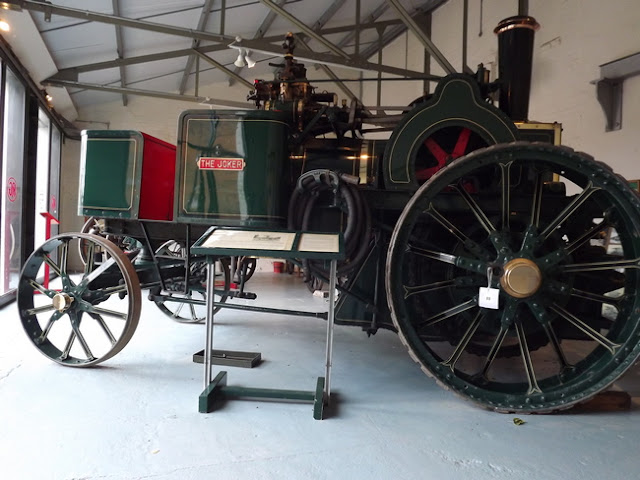Starting Point - Saxmundham Station. A 4.3 mile bike ride to Leiston Long Shop Museum
Part of the former works of Leiston traction engine maker Richard Garrett survives as the Long Shop Museum.
Richard Garrett began as a general engineer in 1778 and by the 1840s specialised in agricultural machinery and portable steam engines. The increasing use of steam in agriculture led to the construction of the Long Shop in 1852. At the Great Exhibition the year before Richard Garrett III picked up ideas from America about production lines where workers specialised on a particular process as the item being worked on passed through the factory. The Long Shop is credited as being the UK's first factory to use the production line system. Boilers would enter the Long Shop on a bogie at one end and be fitted up as they passed along the building's series of bays. Parts would be made upstairs for fitting below. The production line system is often credited to Henry Ford but that would not be for fifty years to come.
The works was connected to the railway at Leiston by a short branch line. Originally wagons were moved by horses. From 1929 to 1962 an Aveling & Porter rail mounted traction engine was used, this was replaced by a battery locomotive made by Electromobile (Leeds) Ltd. More details can be found on
leedsengine.info including a picture of the loco at Leiston. There is a scheme to rebuild part of the former rail link.
Following a fire at the works in 1914 the company expanded with a new works next to Leiston railway station. The two works became known as the Top Works (near the station) and Town Works (including the Long Shop).
Between the wars, in the face of a downturn in the industry as war surplus petrol engined machinery flooded the market, Richard Garrett became part of Agricultural and General Engineers. The group included many of the great and the good of traction engine manufacture including
Burrell's of Thetford and Aveling & Porter of Rochester. The company diversified in to producing Trolleybuses, machine tools and even kitchen white goods. AGE was wound up in 1932 and the Richard Garrett works was taken over by Beyer Peacock. When Beyer Peacock was wound up in the 1970s there were a number of changes in ownership and the company finally disappeared in 1980.
The Top Works survives, divided in to various industrial units as the Master Lord Industrial Estate while part of the Town works survives as the museum and much of the site has been redeveloped.
More information about the Long Shop Museum can be found on
their website.
The railway to Leiston is now just used for freight to the nearby Sizewell nuclear power plant. I cycled from Saxmundham station to Leiston, a distance of 4.3 miles (though buses are available). This bike ride was just following the main roads to Leiston.
Below - The Long Shop
.JPG)
Below - A Garrett traction engine and threshing machine in the works that built them.
Below - A semi-portable engine.
A plough and various pieces made in the forges at the works.
Below - Some of the workshop tools.
Below - Princess Marina, the traction engine displayed in the works.
Below - The threshing machine. The upper floor where parts would be made up for fitting below can be seen.
Below - More of the workshop tools displayed in the former bays.
Below - A view along the production line from the upper level.
Below - One of the ultimate developments in steam tractors before internal combustion took over, the Suffolk Punch Steam Tractor (named after a breed of shire horse) seen in the showroom.
.JPG)
.JPG)
Below - A Merryweather fire engine on display in the showroom.
.JPG)
Below - A Garrett steam roller.
Below - The Aveling & Porter built Sirapite that originally worked on the works railway.
Below - One of the former works buildings now converted to housing. The town works was bound by Main Street, High Street, Cross Street and Park Hill, the museum occupies the north west corner of this site while new housing has been built to the south of the museum and a few other former works buildings have been repurposed.
Below - The former works offices. After the Top Works was built a new larger office complex called Colonial House was built next to the Top Works and this building also survives.
Below - A former board room table and chairs previously belonging to Beyer Peacock. The BP letters can be seen on the chair backs.
.JPG)
.JPG)
.JPG)
.JPG)
.JPG)
.JPG)
.JPG)
.JPG)
.JPG)
.JPG)
.JPG)
.JPG)
.JPG)
.JPG)
.JPG)
.JPG)
.JPG)
.JPG)
.JPG)
.JPG)
.JPG)
No comments:
Post a Comment